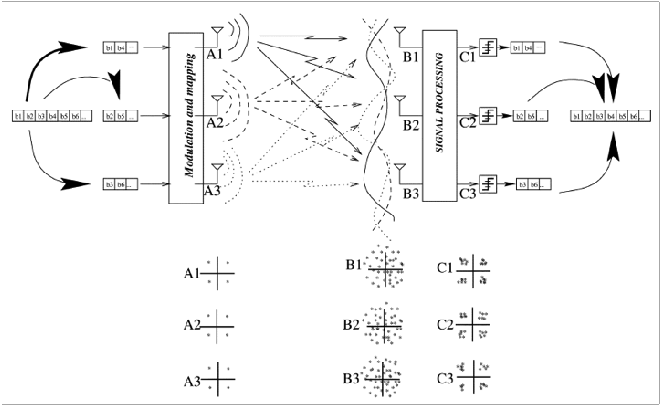

Copyright ©2019 Thomas Schwengler. A significantly updated and completed 2019 Edition is available.
Significantly updated and completed in 2019 Edition available here.
MIMO techniques are the most important advance in recent wireless systems; they are a critical part of important standards such as LTE (and LTE Advanced), HSPA+, WiMax, 802.20, 802.11n/ac/ad The purpose of MIMO is mainly to increase throughput (with multiple streams). MIMO systems are also used to increase reach and lower interference (with beam forming), and to improve data integrity (with coding, preconditioning, diversity).
Bell Labs research started research on MIMO in the 80’s, but one of the turning point might have been the major attention given by the media to BLAST, the Bell Labs Space Time which demonstrated impressive throughput rates.
At least five multi-antenna techniques are used to improve link performance:
The main theoretical aspect of MIMO is one of channel capacity. The Shanon’s capacity theorem for a simple RF channel is:
 | (9.1) |
where C= capacity (bits/s), B=bandwidth (Hz), S∕N= signal to noise ratio.
That capacity equation 1 is widely used and refers to a system with one transmitter, and one receiver (with possibly added diversity, but ultimately combined into one receiver); now we consider a system of N × M antennas: N transmitters, and M receivers.

The H-matrix is a matrix [Hij] defines complex throughput correlation parameters (with amplitude and phase) from each transmit antenna i to each receive antenna j. The new capacity equation for MIMO systems is
 | (9.2) |
where n is the number of independent transmit/receive channels (which is no greater than min(N,M)), and reflects the number of sufficiently uncorrelated paths (It is the rank of the matrix H, and in LTE it is referred to as the rank of the channel), Si are the signal power in channel i, N the noise power, and σi2(H) are singular values of the H matrix.
This channel capacity equation shows that capacity increases linearly with n, which optimally approaches the number of antennas min(N,M). But remember that the channel itself (meaning the propagation media) has a rank, and has a capacity, no matter how many antennas are in the system.
That linear variation is where the value of MIMO lies. In equation (9.1), capacity increases in log 2(1+SNR), which is nearly a linear increase in SNR for small values of SNR (since log(1+x) ≈ x for x ≈ 0), however modern wireless standards tend to aim at higher modulation rates, which require higher SNR, for which log 2(1+SNR) ≈ log 2(SNR), which is a much slower increase in capacity.
MIMO systems include considerations around signal preconditioning, as well as channel predictions, as illustrated in figure 9.2.

Copyright ©2019 Thomas Schwengler. A significantly updated and completed 2019 Edition is available.